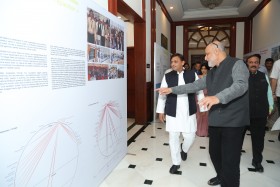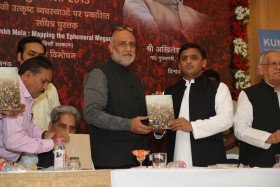 On Monday, August 1, the Harvard University South Asia Institute (SAI) launched the Hindi edition of the book and the exhibition Kumbh Mela: Mapping the Ephemeral Megacity in Lucknow, Uttar Pradesh at the Vivanta by Taj, in partnership with the Uttar Pradesh (UP) Government.
On Monday, August 1, the Harvard University South Asia Institute (SAI) launched the Hindi edition of the book and the exhibition Kumbh Mela: Mapping the Ephemeral Megacity in Lucknow, Uttar Pradesh at the Vivanta by Taj, in partnership with the Uttar Pradesh (UP) Government.
The event drew a large crowd and included Harvard alumni, community members, government officials, students, and members of the public.
The Kumbh Mela: Mapping the Ephemeral Megacity book and exhibition consolidate research findings of the world’s largest religious festival, and serve as an example of interdisciplinary research conducted at Harvard.
 The event featured first-hand insights from Harvard scholars and Kumbh administrators who were on the ground during the festival in 2013, which drew over 50 million pilgrims to Allahabad over the course of 55 days. A Harvard team of 50 faculty members, students, and researchers studied the festival, which was not only a remarkable religious experience, but also a valuable exercise in urban planning, public health, government administration, security, and commerce.
The event featured first-hand insights from Harvard scholars and Kumbh administrators who were on the ground during the festival in 2013, which drew over 50 million pilgrims to Allahabad over the course of 55 days. A Harvard team of 50 faculty members, students, and researchers studied the festival, which was not only a remarkable religious experience, but also a valuable exercise in urban planning, public health, government administration, security, and commerce.
When the English edition of the book was released in New Delhi last year, Shri Akhilesh Yadav, Honorable Chief Minister of Uttar Pradesh, explained that a Hindi edition would help in disseminating the learnings and communicate the grandeur of the Kumbh Mela to populace across India. This Hindi book launch is a culmination of all the efforts since then. The book has been translated by Bal Kishan Bali.
Meena Hewett, Executive Director, Harvard University South Asia Institute, welcomed the dignitaries and the audience. She expressed that the interdisciplinary research on the Kumbh Mela has been very fruitful and thanked the UP Government for facilitating the research process. She explained that the book shall serve as a guide to organize large scale events across the globe in various settings.
 Javed Usmani, then Chief Secretary and now Chief Information Officer (CIC), Uttar Pradesh Government, recounted his experience at the festival. He reflected on how it was a very big challenge for the new government to host the event considering the fact that they had just 9 months to plan and organize the whole event, while an existing government would typically have much more than a year’s time to do the same.
Javed Usmani, then Chief Secretary and now Chief Information Officer (CIC), Uttar Pradesh Government, recounted his experience at the festival. He reflected on how it was a very big challenge for the new government to host the event considering the fact that they had just 9 months to plan and organize the whole event, while an existing government would typically have much more than a year’s time to do the same.
Around 20 departments of the State Government, 6 departments of the Central Government, religious institutions, non-profit organizations, and partners from the formal and informal came together to execute the Kumbh Mela: More than 690 kilometers of pipelines were laid for drinking water supply; around 800 kilometers of power lines were laid; around 25,000 street lights were installed; 18 pontoon bridges were constructed to hold 500,000 people per hour; 20,000 police personnel, to ensure safety of pilgrims and prevent terrorism; 34,000 toilets with bio-digester technology; 7,000 sanitation workers who were deployed round the clock, amongst many others.
Rahul Mehrotra, Professor of Urban Design and Planning at the Harvard Graduate School of Design, narrated his experience from a design and urban planning perspective. According to him, the level and kind of complexity associated with the Kumbh Mela is unique. This is the first time a systematic mapping of the Kumbh Mela has been done.
 Mehrotra explained that the book’s research is focused on the following areas: Urbanism, Business, Religion, Technology, Health, Governance and Engineering. The lessons from this study can be used in various other settings like urban planning, refugee camps, disaster management, rehabilitation, mass gatherings for various purposes amongst many others.
Mehrotra explained that the book’s research is focused on the following areas: Urbanism, Business, Religion, Technology, Health, Governance and Engineering. The lessons from this study can be used in various other settings like urban planning, refugee camps, disaster management, rehabilitation, mass gatherings for various purposes amongst many others.
Alok Sharma, Inspector General (IG) of Police, Uttar Pradesh Government, shared his experience of the immense challenges his team of policemen faced at an event attended by crores of pilgrims from across the world. He thanked the Chief Minister for having given them a lot of accountability and responsibility to handle the event. The amount of pressure felt during the event was like never before for the police team. Policemen were given the freedom to act in the best interests of the pilgrims at any point in time and not wait for orders from seniors to make decisions which could be handled at their end.
The exhibition and book have previously been launched in New Delhi with Shri Akhilesh Yadav, Honorable Chief Minister of Uttar Pradesh, at Harvard University with President Drew Faust, at the Asia Society in New York City, and at the Chhatrapati Shivaji Maharaj Vastu Sangrahalaya in Mumbai.
– Kundan Madireddy, Project Manager, Social Entrepreneurship and Livelihood Creation in India
Media:
